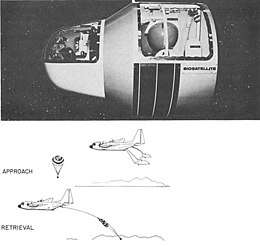Biosatellite
A biosatellite is an artificial satellite designed to carry plants or animals in outer space. They are used to research the effects of space (cosmic radiation, weightlessness, etc.) on biological matter while in orbit around a celestial body. The first satellite carrying an animal (a dog, "Laika") was Soviet Sputnik 2 on November 3, 1957. On August 20, 1960 Soviet Sputnik 5 launched and recovered dogs from orbit Earth orbit.
 Drwaing of Biosatellite and Retrieval | |
| Applications | To carry plants or animals in outer space |
|---|---|
| Specifications | |
| Spacecraft type | Artificial satellite |
NASA launched three satellites between 1966 and 1969 for the Biosatellite program.[1][2]
The most famous biosatellites include:
- Biosatellite program launched by NASA between 1966 and 1969.
- Bion space program by Soviet Union
- The Mars Gravity Biosatellite
- Orbiting Frog Otolith (OFO-A)
See also
- Animals in space
- Biosatellite (NASA)
References
- Biosatellite, David Darling's Internet Encyclopedia of Science
- Biosatellite, Encyclopedia Astronautica
This article is issued from Wikipedia. The text is licensed under Creative Commons - Attribution - Sharealike. Additional terms may apply for the media files.